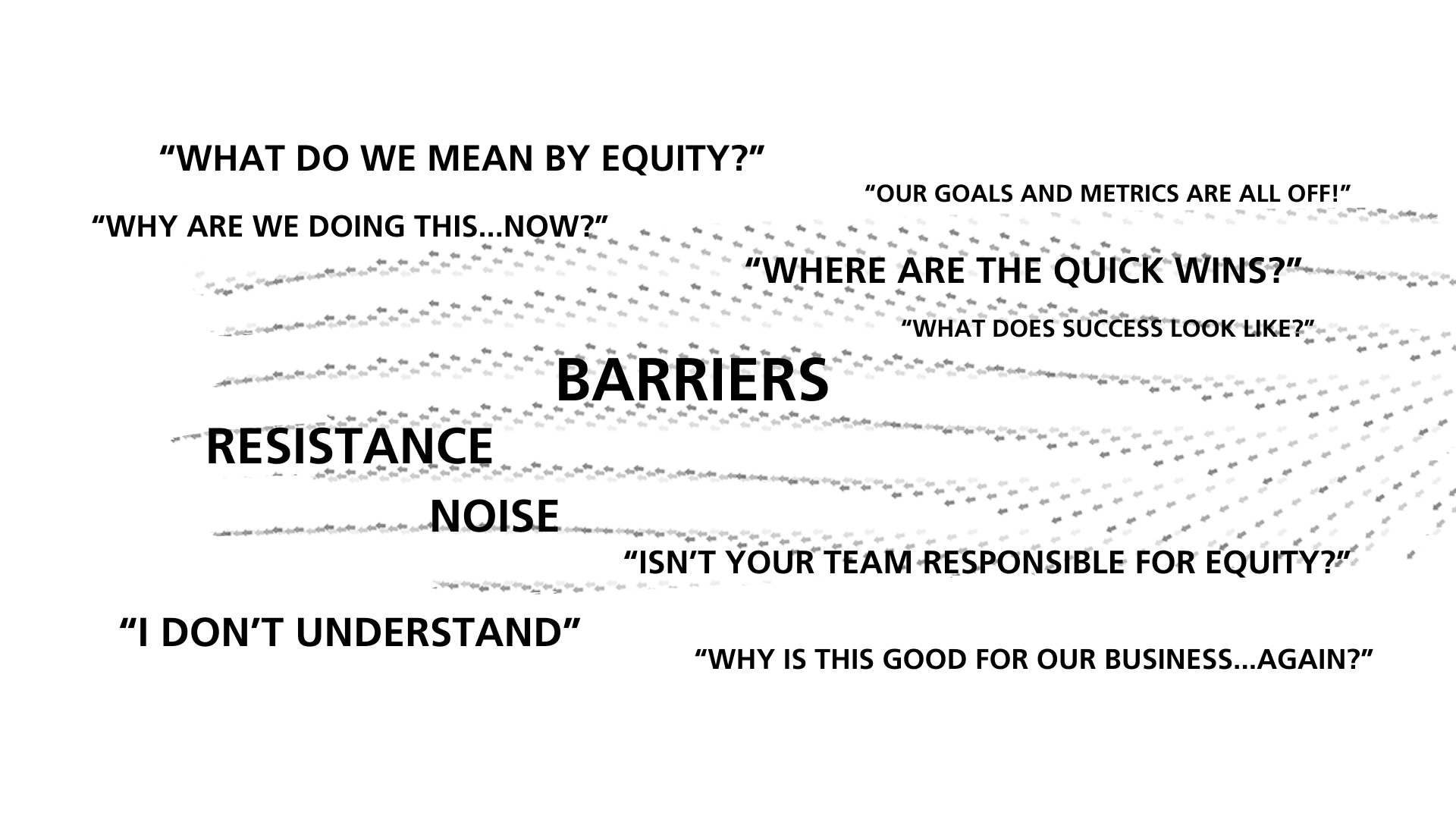
How Corporate Changemakers Can Overcome Internal Resistance to Change
If you are a frequent flyer, you’ve likely experienced the groan-inducing announcement from the flight deck that headwinds are particularly strong, and the flight will be longer than usual. In business, leaders also face headwinds—or interference, the powerful and often invisible forces impeding progress and growth. Similar to how pilots have built-in systems to help them anticipate and navigate interference when flying, we believe that corporate changemakers need tools to properly diagnose interference and build enabling conditions for social impact strategies to thrive.
Over the past few years, there has been a significant surge in corporate commitments to advance social and environmental impacts with more equitable outcomes for all. As leaders of a consulting firm that advises corporate social impact, sustainability, and equity leaders, we’ve observed these corporate changemakers encounter resistance to change now that they’re moving from commitment to action. This interference can look like persistent questions about why equity is good for the business, responsibility for more equitable outcomes without the necessary authority and resources, or other organizational design or cultural barriers that make change harder. In the fall of 2023, we facilitated a cohort of corporate leaders responsible for advancing enterprise-wide health equity strategies to share and workshop the internal roadblocks they are encountering. This learning cohort represented the inaugural FSG Purpose Studio—a collaborative learning experience for corporate leaders doing the hard work of social change from inside companies.
Inspired by others who have written about interference in corporate settings, we proposed the following equation to help leaders achieve greater social impact:

By reducing interference, a company can achieve more of its strategic intent and increase the social impact it seeks to make with its equity strategies. To be successful, corporate changemakers need to diagnose the interference and build an operating environment that allows strategy to take hold and flourish—in other words, build what we call enabling conditions.
Why Reducing Interference Matters
Interference Diminishes the Impact of Strategy
Well-designed strategies have an intended outcome—what you want to see change, grow, or improve because of the actions you put into play. In the cohort of health equity leaders we gathered, we discussed the example of a company who aspires to make medical innovations more readily available to all patients rather than those who can pay for advanced products and services. A dedicated group of health equity advocates inside the company is driving this strategy but is colliding with the company-wide mental model that innovation causes costs to rise proportionately. This limits the ability to even explore solutions that are innovative and accessible from a cost standpoint. Addressing this interference is crucial for the health equity strategy’s success.
Interference Decreases the Potential of Purpose
Companies that lead with purpose can make a profound impact on society while making themselves more competitive, profitable and compelling places to work, with the data to back it up. Delivering impact through philanthropy or employee volunteerism is needed and admirable, but leveraging the core business is the most comprehensive way that a company can live out its purpose by driving sustainable, scalable innovation and growth.
In our work advising corporate changemakers, we have witnessed a pattern. The deeper the work gets into the core business, the less control and authority changemakers typically have and the higher the level of interference. For example, a leader in corporate giving may need few internal stakeholders to approve philanthropic grants for organizations working to reduce inequities. However, a leader seeking to advance equity through product pricing and distribution will need to work with many internal and external stakeholders to bring the effort to fruition. With these added stakeholders and potentially conflicting priorities, headwinds can quickly materialize. Without creating conditions to reduce such interference, companies cannot optimize the power of their purpose and create greater impact for society.
Interference Can Negatively Influence Culture
Interference, in its many forms, often reflects a company’s culture and can also reinforce norms that make it hard to innovate, collaborate, and take risks. A culture that overly prioritizes short-term profit and immediate wins can miss big disruptions on the horizon (e.g., smartphones, short-term rentals, streaming services). Interference can also show up as holding on to the status quo, which is particularly hard on those advocating for greater equity and systems change. Culture is hard to shift without intention, and a culture that doesn’t want to shift will continue to find ways to reinforce itself, thereby compounding the negative influences of interference.
Three Steps to Help
Interference is real and could be getting in the way of your strategies’ potential, so how do you address it? First, aim to see where interference is present; then, name the noise that is suboptimizing your strategies; and, finally, develop a set of conditions to minimize the interference that is most problematic to the impact your company hopes to make.
 1. Recognize the Interference
1. Recognize the Interference
Interference isn’t always tangible and explicit, making it challenging to diagnose. To help surface all types of interference, we recommend using a framework called the Six Conditions of Systems Change to inventory interference along your journey. The six conditions include: 1) policies, 2) practices, 3) resource flows, 4) relationships, 5) power dynamics, and 6) mental models.
While the framework is not designed to give you the answers, for many, it helps them see the problem for the first time, and that is a big step towards addressing it. For example, while most leaders we engaged had identified explicit interferences related to resources (e.g., limited investment to build staff capacity on health equity), the framework helped them surface additional interferences related to relationships and power dynamics (e.g., health equity teams were perceived less important to the bottom line by business leaders).
 2. Give it a Name
2. Give it a Name
Once the interference has been identified, naming it makes it real and helps others acknowledge what is happening. For example, the question of “why is this good for our business?” can showcase the interference taking shape as lacking articulation of a business case for impact. Similarly, the question of “isn’t your team responsible for equity?” can reveal that executives and commercial leaders don’t see equity as their job.
 3. Create Enabling Conditions
3. Create Enabling Conditions
To help manage and mitigate the interference you have now named, leaders must develop the enabling conditions for strategy to take hold and flourish. This work can be hard and may require you to call on your relationships, the credibility and trust you’ve built within your organization, the clarity of your strategy, and sometimes courage. In our learning cohort, one team noticed that health equity decisions in their hypothetical company were isolated from a commercial perspective, leading to under-supported and unsustainable outcomes. To improve outcomes, cohort leaders recommended breaking down structural silos and promoting shared participation through joint steering committees. They proposed linking performance incentives between core business and health equity groups, implementing rigorous health equity efforts that could stand up to business scrutiny, and shifting the company’s culture to value all employees as sources of solutions, rather than a select team. Enabling conditions can tangibly shift behaviors and mindsets, reducing interference and helping companies realize the impact of their strategies. While not easy, committing to creating enabling conditions will increase the likelihood that the change you hope to realize will be supported and sustained, and that leads to real impact.
Interference—like headwinds when flying—is inevitable, particularly for those agitating for change. Much like pilots, when equity leaders can recognize and name those prevailing winds, they can better shift their approach and create the conditions for a smoother journey. And as the interference is reduced, corporate changemakers can unlock more of the potential of their purpose, culture, and strategies and get closer to creating a more equitable society.
Special thanks to FSG’s Njideka Ofoleta, Mikayla Redding and Maria Marta Habich for their contributions to the inaugural Purpose Studio.

 1. Recognize the Interference
1. Recognize the Interference 2. Give it a Name
2. Give it a Name 3. Create Enabling Conditions
3. Create Enabling Conditions



